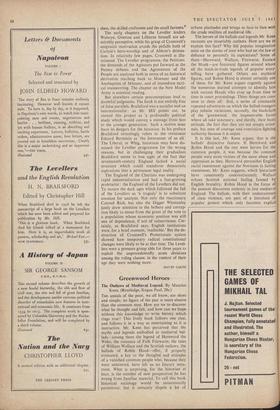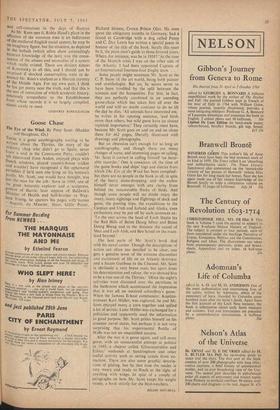Greenwood Heroes
THE annals of the poor, we all know, are short and simple; no figure of the past is more elusive than the common man. How are we to discover what he thought and felt, and how can we hope without this knowledge to write history which rings true? This lively book follows one clue, and follows it in a way as entertaining as it is instructive. Mr. Keen has perceived that the myths and legends embodied in medimval bal- lads—among them the legend of Hereward the Wake, the romance of Fulk Fitzwarin, the tales of William Wallace and the Scottish outlaws, the ballads of Robin Hood—offer, if properly evaluated, a key to the thoughts and attitudes of a vanished common people who, because they were unlettered, have left us no literary testa- ment. What is surprising, for the historian at least, is the number of new perspective § he has wrung from familiar material. To call this book historical sociology would . be unnecessarily portentous; but it certainly dispels a lot of
urbane platitudes and brings us Lace to face with the crude realities of medimval life.
The heroes of the ballads and legends Mr. Keen recounts are invariably outlaws. How are we to explain this fact? Why did popular imagination seize on the stories of men who had set the law at defiance to personify its aspirations? Some of them—Hereward, Wallace, Fitzwarin, Eustace the Monk—are historical figures around whom all the stock-in-trade legends of popular story- telling have gathered. Others are mythical figures, and Robin Hood is almost certainly one of these, for Mr Keen argues cogently against the numerous learned attempts to identify him with various Hoods who crop up from time to time in court proceedings. Three things are com- mon to them all: first, a series of constantly repeated adventures on which the ballad-mongers play infinite variations; secondly, the backcloth of the 'greenwood,' the impenetrable forest where all take sanctuary; and thirdly, their basic attitude, the fact that they are not simply crimi- nals, but men of courage and conviction fighting authority because it is unjust.
It is this last, Mr. Keen argues, that is the ballads' distinctive feature. If Hereward and Robin Hood and the rest were heroes for the common people, it was because the common people were mute victims of the same abuse and oppression as they. Hereward personifies English racial resentment against the Normans (a lasting resentment, Mr. Keen suggests, which historians have consistently underestimated); Wallace echoes Scottish national feeling fanned by English brutality; Robin Hood is the focus of the peasant discontent endemic in late mediwval: England. The ballads, with their undercurrentS of class violence, are part of a literature of- popular protest which only becomes explicit
and self-conscious in the days of Bunyan. As Mr. Keen sees it, Robin Hood's place in the affection of the common man is an indictment of the medieval English social system; he may be an imaginary figure, but his situation, as depicted in the ballads (which often show astoundingly accurate knowledge of the law), was the conse- quence of the abuses and anomalies of a system which really existed. There are distinct echoes ot Kosminsky in all this, and I should not be surprised if shocked conservatives were to de- nounce Mr. Keen's analysis as a Marxist travesty of the Middle Ages. For my own part, I think he has got pretty near the truth, and that this is the sort of correction of which academic history, inherently sympathetic to the Establishment from whose records it is so largely compiled. stands sorely in need.
GEOFFREY BARRACLOL'Gli



























































 Previous page
Previous page